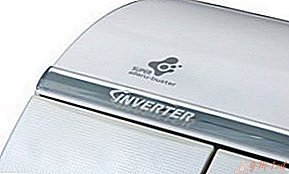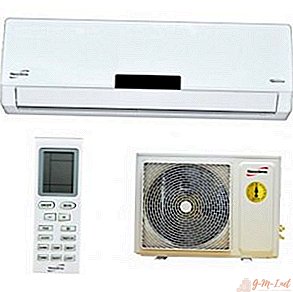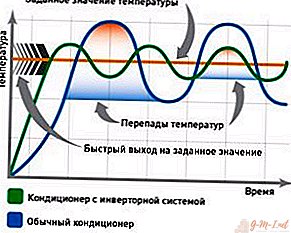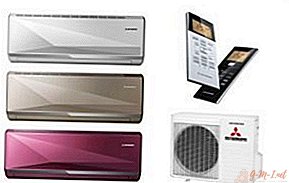 Inverter air conditioner or inverter, this is an improved version of a conventional air conditioner, working on the principle of double voltage conversion. After reading this article, you will learn about why such air conditioners are more expensive than they are better, and how to choose the model that suits you.
Inverter air conditioner or inverter, this is an improved version of a conventional air conditioner, working on the principle of double voltage conversion. After reading this article, you will learn about why such air conditioners are more expensive than they are better, and how to choose the model that suits you.
To understand what is the difference between an inverter and a classic air conditioner, you need to have a general understanding of the design of this equipment.
As you know, air conditioning consists of two main blocks - external and internal. The indoor unit monitors the temperature of the room to be cooled by means of a sensor and sends a signal to the condenser to change the operating mode. Also in the indoor unit is an evaporator in which the refrigerant (freon for household appliances) changes its state of aggregation from liquid to gaseous, absorbing the thermal energy of the environment. So there is a decrease in room temperature.

In the external unit is another important element of the system - a capacitor. In it, under the influence of a compressor, freon passes back from gaseous to liquid form and releases heat to the environment. This heat is removed using a radiator and a fan.
A conventional air conditioner has only two modes of operation - it runs at full power or is inactive. Thus, the temperature is regulated quite roughly. From time to time, excess cold is formed in the system, which must be discharged into the environment, which leads to inefficient operation of the device.
The inverter compressor can operate at different capacities. Thus, the heat exchange process between the blocks, and hence the cooling of the room, will proceed more smoothly and accurately.
The inverter built into the air conditioner is a converter of alternating electric current to direct current and vice versa. This allows you to control the compressor through a frequency of voltage, which in the electric network is constant and is 50 Hz.
At the input of the inverter receives alternating current and is converted to direct current. Then, inverse conversion to alternating current is performed, and the output frequency is formed, which is necessary for the capacitor to provide the desired heat transfer rate.
The control unit of the device reads the value from the temperature sensor and adjusts the frequency of the inverter at the output, changing the intensity of the compressor.

When starting up, the split system turns on at full power until the temperature of the room to be cooled approaches the set temperature. In the classics there is a peak voltage surge caused by the start of the compressor. The inverter electronics allows a soft start and maximum power output.
After entering the mode, the compressor does not turn off just like in a traditional air conditioner. It reduces power to about 10% of the nominal. As soon as the room temperature rises above, the power of work increases in the limit of comfortable loads.
Benefits inverter systems stem from the principle of their work:
- more economical at start and modes far from ultimate power;
- can function for a long time, not limited to 8 hours a day, as in classic models;
- more durable due to the absence of shock loads and the operation of system parts near the maximum power level;
- more accurate temperature maintenance (1-1,50C) due to changes in the frequency of the compressor;
- option of heating in the cold season - the properties of freon allow this to be done at temperatures up to -250WITH;
- lack of network congestion, since the device mainly operates at optimal capacities;
- less noisy - for the same reason;
- provide more comfortable cooling in comparison with traditional devices.

disadvantages Inverter air conditioners are as follows:
- first of all, they are significantly more expensive;
- the presence of losses during double current conversion;
- more demanding on the quality of the power grid - the electronic control unit may not suffer power surges;
- due to the presence of the inverter, the external unit has become more overall and heavy, which somewhat complicates the installation process and imposes additional requirements on the strength of the structure;
- more expensive to operate and repair due to the availability of a larger number and variety of spare parts.
The efficiency of the inverter device can be both an advantage and its disadvantage. It all depends on the mode of its operation: upon reaching the set temperature after switching on and working in the optimal frequency range, the absence of idle losses and the smooth operation of the compressor will block the losses due to double current conversion.
However, if the device will be used at close to maximum power continuously, the inverter will not be able to realize its advantages, while losses from double current conversion can lead to a significant deterioration in efficiency compared to traditional models. The efficiency of each converter is not more than 90%, which means that we are talking about constant net losses, depending on power.
Thus, two conclusions can be drawn:
- inverters are not recommended for use in rooms such as kitchens where heat-generating appliances are installed - stoves, kettles and the like or office spaces with large air exchange;
- particular attention should be paid to power selection and provide the necessary margin for the long and efficient operation of the inverter device.
To determine the best manufacturers and, especially, models, it is necessary to identify evaluation criteria. Depending on their use, different requirements will be presented. For example, you can talk about the best models for allergy sufferers, for use in dormitory rooms, about systems for universal use or economy options.
According to the rating of one of the suppliers specializing in climate systems, in the category of highly reliable inverters Japanese brands occupy leading positions: Daikin, Mitsubishi Electric, Mitsubishi Heavy Industries.

Among the highly reliable three winners were also Japanese manufacturers: TOSHIBA, Mitsubishi Heavy Industrie, HITACHI.
The leaders in popularity among economy class models are:
- Ballu (Russia);
- Lessar (Czech);
- General Climate (Russia).
Like any other equipment, an air conditioning system requires regular monitoring and maintenance. During operation, the inverter pumps a huge amount of air that is contaminated with dust particles, especially on the lower floors of megalopolises' houses. All this dust settles on the filters and partially penetrates the inside of the external unit.
In the absence of care, the system creates conditions for the growth of bacteria, mold forms, which ultimately can lead to failure of the units or even become a potential source of bacterial diseases in a refrigerated room.
To avoid these negative consequences, it is necessary to carry out routine maintenance of the inverter, including antibacterial treatment, filter replacement, route checking and refrigerant replacement / refueling, cleaning the heat exchanger and other necessary operations.
It is also recommended that you check the oil and freon levels from time to time.

Leave Your Comment